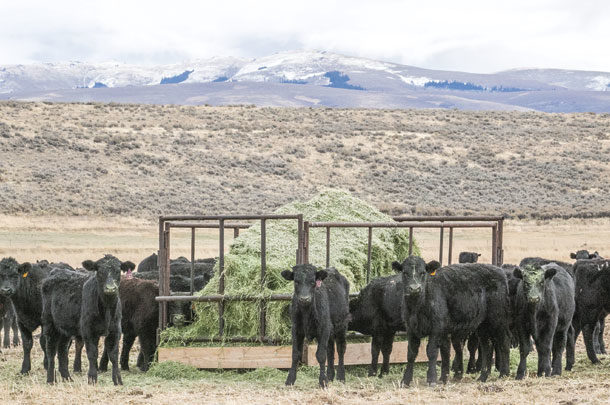The overall goal of a weaning program should be to prepare calves to perform better as stockers, feeders or replacement heifers. When done well, weaning results in reduced health problems, increased average daily gain, improved feed efficiency and, ultimately, increased animal value. Because of less sickness, less death loss and improved performance, order buyers and feedlots can afford to pay a premium for properly weaned calves.
To receive this premium, calves should be sold in special weaned calf sales or in truckload lots. Additionally, properly weaned calves will shrink less than unweaned calves. This can mean an additional 25 pounds or more to sell if shrink is reduced by 5 percentage points.
There are a number of different methods used to wean calves. Some common methods are listed below.
1. Fenceline weaning
Cows and calves are put in adjacent pastures. This method allows the cows and calves to see, hear and smell each other, which reduces stress on both. A single strand of electric fence attached to the permanent fence works great to keep calves in when dealing with marginal permanent fences.
2. Two-stage weaning
With this method, a mechanical device is placed in the calves’ noses for four to seven days that prevents them from nursing while they remain with their dams. After the four to seven days, the calves are separated from the cows, and the devices are removed. This method does require additional trips through the chute.
3. Putting calves in a pasture that is two to three pastures away from their dams
This method seems like a great idea because it keeps calves on pasture and in an environment that they are familiar with. However, what often happens is it results in fence repairs because some cows will go through or over fences trying to get back to a pasture next to their calves.
4. Putting calves in a corral
The advantage of this method is producers don’t have to worry about calves or cows going through the fence and getting back together. However, feed costs are higher with this method. Calves are also confined to a small area that is often dusty, which can lead to increased health problems.
5. Transporting calves to a new location, often either an auction market or feedlot
This method can be one of the hardest on calves, especially if they are transported directly to an auction market and commingled with other cattle. If this method is used, it is best to send the calves directly to a stocker operator, background yard or feedlot.
Regardless of which method is used, the goals during the weaning period should include:
- Keeping calves growing at a moderate rate (e.g., 0.75 to 1.5 pounds per day)
- Keeping the rumen healthy
- Increasing immune function
- Controlling costs
Contrary to the belief by some, maximizing weight gain during the 45- to 60-day weaning period is often not the best approach. When trying to maximize gain during the weaning period, it is easy to spend more money on feed than the increased calf value will justify. Remember, the value of added weight gain is often about 80 cents per pound. It is important to calculate value of gain for current market and feed conditions to ensure added feed costs don’t exceed the value of additional weight gain.
From a cost and rumen health standpoint, weaning calves on moderate- to high-quality forage is ideal. Consequently, it is important to plan ahead so there will be abundant moderate- to high-quality forage available at the weaning pasture.
Keeping the rumen healthy is important for long-term health and profitability. Cattle are designed to eat grass and other forages. Starting calves on 0.5 to 1 pound of a high-protein supplement like cottonseed meal works well. After they are eating well, the cottonseed meal can be continued, or the calves can be transitioned to another type of supplement depending on forage quality.
One really nice thing about cottonseed meal and other similar high-protein supplements is the change in rumen pH is less than with grains and other concentrate supplements. Consequently, these high-protein supplements provide a large safety factor if one calf eats more than its share of feed.
If grains and other concentrate feeds are added to the diet, they should be added gradually over time. One approach would be to start calves at 0.15% of their bodyweight and then increase in increments of about 0.15% of bodyweight every three to four days if they are eating and doing well. For a 650-pound calf, this would result in starting at 1 pound of feed per day and then increasing by 1 pound every three to four days. During the entire time, calves should have free-choice access to high-quality pasture or hay and a complete mineral supplement.
Fenceline weaning and two-stage weaning have proven to be the best for reducing stress and increasing calf performance. With these two approaches, calves will walk the fences less and continue to gain weight during the weaning period. Regardless of which method is used, it is critical to separate cows from calves in a calm and quiet manner. Other stressful events like castration and dehorning should be performed when calves are less than 3 months of age, and not at weaning.
If possible, select pastures to put calves in that are 5 to 20 acres in size with a good water source within a few hundred yards of the fence. Good shade along the fence is critical if calves will be weaned during hot weather. Additionally, pairs should be supplemented before weaning to aid in teaching calves to eat once they are weaned – five to seven times is normally sufficient. When done correctly, weaning can be easy and profitable for producers. ![]()
PHOTO: While no weaning method is without its flaws, if done correctly, weaning can increase animal value and reduce shrink. Photo by Lynn Jaynes.

-
Jason Banta
- Associate Professor and Extension Beef Cattle Specialist
- Texas A&M University
- Email Jason Banta










